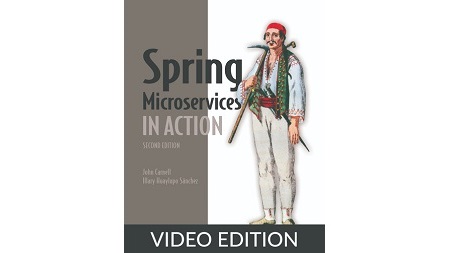English | MP4 | AVC 1280×720 | AAC 44KHz 2ch | 80 Lessons (11h 29m) | 938 MB
A must-have for any professional Spring microservice developer’s bookshelf!
Iain Campbell, Tango Telecom
By dividing large applications into separate self-contained units, Microservices are a great step toward reducing complexity and increasing flexibility. Spring Microservices in Action, Second Edition teaches you how to build microservice-based applications using Java and the Spring platform. This second edition is fully updated for the latest version of Spring, with expanded coverage of API routing with Spring Cloud Gateway, logging with the ELK stack, metrics with Prometheus and Grafana, security with the Hashicorp Vault, and modern deployment practices with Kubernetes and Istio.
Building and deploying microservices can be easy in Spring! Libraries like Spring Boot, Spring Cloud, and Spring Cloud Gateway reduce the boilerplate code in REST-based services. They provide an effective toolbox to get your microservices up and running on both public and private clouds.
Spring Microservices in Action, Second Edition teaches you to build microservice-based applications using Java and Spring. You’ll start by creating basic services, then move to efficient logging and monitoring. Learn to refactor Java applications with Spring’s intuitive tooling, and master API management with Spring Cloud Gateway. You’ll even deploy Spring Cloud applications with AWS and Kubernetes.
What’s inside
- Microservice design principles and best practices
- Configuration with Spring Cloud Config and Hashicorp Vault
- Client-side resiliency with Resilience4j, and Spring Cloud Load Balancer
- Metrics monitoring with Prometheus and Grafana
- Distributed tracing with Spring Cloud Sleuth, Zipkin, and ELK Stack
Table of Contents
1 Welcome to the cloud, Spring
2 What’s a microservice
3 Microservices with Spring
4 Cloud and microservice-based applications
5 Why the cloud and microservices
6 Core microservice development pattern
7 Microservice logging and tracing patterns
8 Exploring the microservices world with Spring Cloud
9 Spring Cloud by example
10 Codebase
11 Dev prod parity
12 Getting started with the skeleton project
13 Building microservices with Spring Boot
14 Establishing service granularity
15 When not to use microservices
16 Building the doorway into the microservice – The Spring Boot controller
17 Adding internationalization into the licensing service
18 The DevOps story – Building for the rigors of runtime
19 Service registration and discovery – How clients communicate with your microservices
20 Welcome to Docker
21 What is Docker
22 Integrating Docker with our microservices
23 Creating Docker images with Spring Boot
24 Controlling your configuration with the Spring Cloud Configuration Server
25 Building our Spring Cloud Configuration Server
26 Setting up the Spring Cloud Config bootstrap class
27 Integrating Spring Cloud Config with a Spring Boot client
28 Configuring the licensing service to use Spring Cloud Config
29 Directly reading properties using @ConfigurationProperties
30 Vault UI
31 On service discovery
32 Service discovery in the cloud
33 Service discovery in action using Spring and Netflix Eureka
34 Registering services with Spring Eureka
35 Using service discovery to look up a service
36 Invoking services with a Load Balancer–aware Spring REST template
37 When bad things happen – Resiliency patterns with Spring Cloud and Resilience4j
38 Why client resiliency matters
39 Setting up the licensing service to use Spring Cloud and Resilience4j
40 Fallback processing
41 Implementing the retry pattern
42 ThreadLocal and Resilience4j
43 Service routing with Spring Cloud Gateway
44 Introducing Spring Cloud Gateway
45 Configuring routes in Spring Cloud Gateway
46 The real power of Spring Cloud Gateway – Predicate and Filter Factories
47 Building the pre-filter
48 UserContextFilter – Intercepting the incoming HTTP request
49 Securing your microservices
50 Starting small – Using Spring and Keycloak to protect a single endpoint
51 Configuring O-stock users
52 Protecting the organization service using Keycloak
53 Propagating the access token
54 Some closing thoughts on microservice security
55 Chapter 10. Event-driven architecture with Spring Cloud Stream
56 Chapter 10. Using messaging to communicate state changes between services
57 Chapter 10. Writing a simple message producer and consumer
58 Chapter 10. Writing the message consumer in the licensing service
59 Chapter 10. A Spring Cloud Stream use case – Distributed caching
60 Chapter 10. Using Redis to cache lookups
61 Chapter 11. Distributed tracing with Spring Cloud Sleuth and Zipkin
62 Chapter 11. Log aggregation and Spring Cloud Sleuth
63 Chapter 11. Defining and running ELK Stack applications in Docker
64 Chapter 11. Searching for Spring Cloud Sleuth trace IDs in Kibana
65 Chapter 11. Configuring a Zipkin server
66 Chapter 11. Visualizing a more complex transaction
67 Chapter 12. Deploying your microservices
68 Chapter 12. The architecture of a build deployment pipeline
69 Chapter 12. Setting up O-stock’s core infrastructure in the cloud
70 Chapter 12. Beyond the infrastructure – Deploying O-stock and ELK
71 Chapter 12. Creating an EKS cluster
72 Chapter 12. Creating an EKS cluster
73 Chapter 12. Your build deployment pipeline in action
74 Chapter 12. Enabling our services to build in Jenkins
75 Chapter 12. Understanding and generating the pipeline script
76 Appendix A. Microservices architecture best practices
77 Appendix B. OAuth2 grant types
78 Appendix B. Authorization grant type
79 Appendix C. Monitoring your microservices
80 Appendix C. Implementing Micrometer and Prometheus
Resolve the captcha to access the links!
